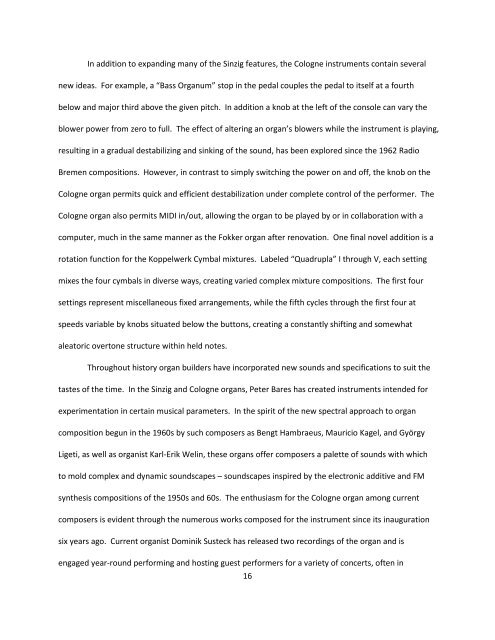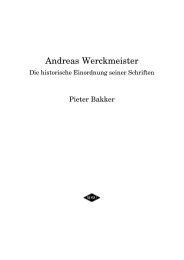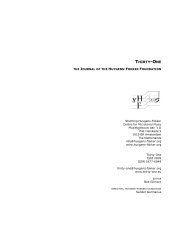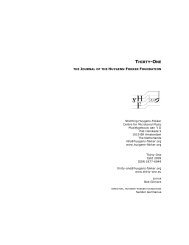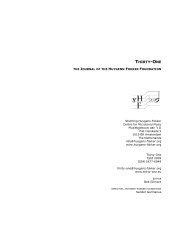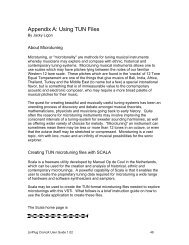Recent Organ Design Innovations and the 21st-century - Stichting ...
Recent Organ Design Innovations and the 21st-century - Stichting ...
Recent Organ Design Innovations and the 21st-century - Stichting ...
Create successful ePaper yourself
Turn your PDF publications into a flip-book with our unique Google optimized e-Paper software.
In addition to exp<strong>and</strong>ing many of <strong>the</strong> Sinzig features, <strong>the</strong> Cologne instruments contain several<br />
new ideas. For example, a “Bass <strong>Organ</strong>um” stop in <strong>the</strong> pedal couples <strong>the</strong> pedal to itself at a fourth<br />
below <strong>and</strong> major third above <strong>the</strong> given pitch. In addition a knob at <strong>the</strong> left of <strong>the</strong> console can vary <strong>the</strong><br />
blower power from zero to full. The effect of altering an organ’s blowers while <strong>the</strong> instrument is playing,<br />
resulting in a gradual destabilizing <strong>and</strong> sinking of <strong>the</strong> sound, has been explored since <strong>the</strong> 1962 Radio<br />
Bremen compositions. However, in contrast to simply switching <strong>the</strong> power on <strong>and</strong> off, <strong>the</strong> knob on <strong>the</strong><br />
Cologne organ permits quick <strong>and</strong> efficient destabilization under complete control of <strong>the</strong> performer. The<br />
Cologne organ also permits MIDI in/out, allowing <strong>the</strong> organ to be played by or in collaboration with a<br />
computer, much in <strong>the</strong> same manner as <strong>the</strong> Fokker organ after renovation. One final novel addition is a<br />
rotation function for <strong>the</strong> Koppelwerk Cymbal mixtures. Labeled “Quadrupla” I through V, each setting<br />
mixes <strong>the</strong> four cymbals in diverse ways, creating varied complex mixture compositions. The first four<br />
settings represent miscellaneous fixed arrangements, while <strong>the</strong> fifth cycles through <strong>the</strong> first four at<br />
speeds variable by knobs situated below <strong>the</strong> buttons, creating a constantly shifting <strong>and</strong> somewhat<br />
aleatoric overtone structure within held notes.<br />
Throughout history organ builders have incorporated new sounds <strong>and</strong> specifications to suit <strong>the</strong><br />
tastes of <strong>the</strong> time. In <strong>the</strong> Sinzig <strong>and</strong> Cologne organs, Peter Bares has created instruments intended for<br />
experimentation in certain musical parameters. In <strong>the</strong> spirit of <strong>the</strong> new spectral approach to organ<br />
composition begun in <strong>the</strong> 1960s by such composers as Bengt Hambraeus, Mauricio Kagel, <strong>and</strong> György<br />
Ligeti, as well as organist Karl-Erik Welin, <strong>the</strong>se organs offer composers a palette of sounds with which<br />
to mold complex <strong>and</strong> dynamic soundscapes – soundscapes inspired by <strong>the</strong> electronic additive <strong>and</strong> FM<br />
syn<strong>the</strong>sis compositions of <strong>the</strong> 1950s <strong>and</strong> 60s. The enthusiasm for <strong>the</strong> Cologne organ among current<br />
composers is evident through <strong>the</strong> numerous works composed for <strong>the</strong> instrument since its inauguration<br />
six years ago. Current organist Dominik Susteck has released two recordings of <strong>the</strong> organ <strong>and</strong> is<br />
engaged year-round performing <strong>and</strong> hosting guest performers for a variety of concerts, often in<br />
16


